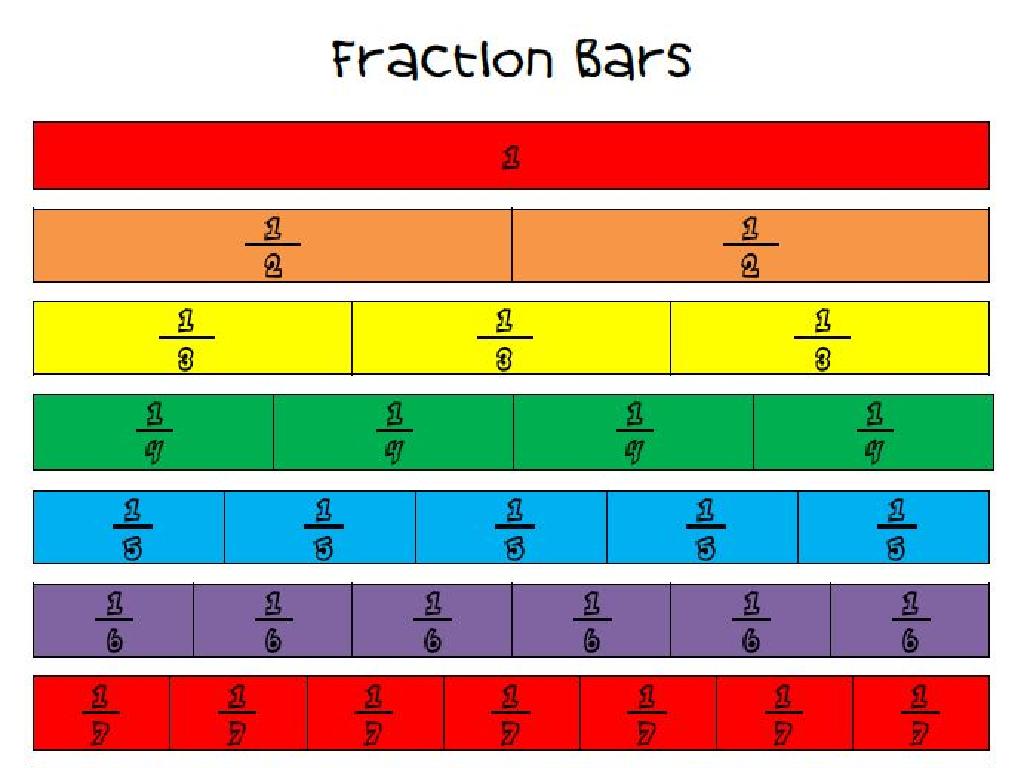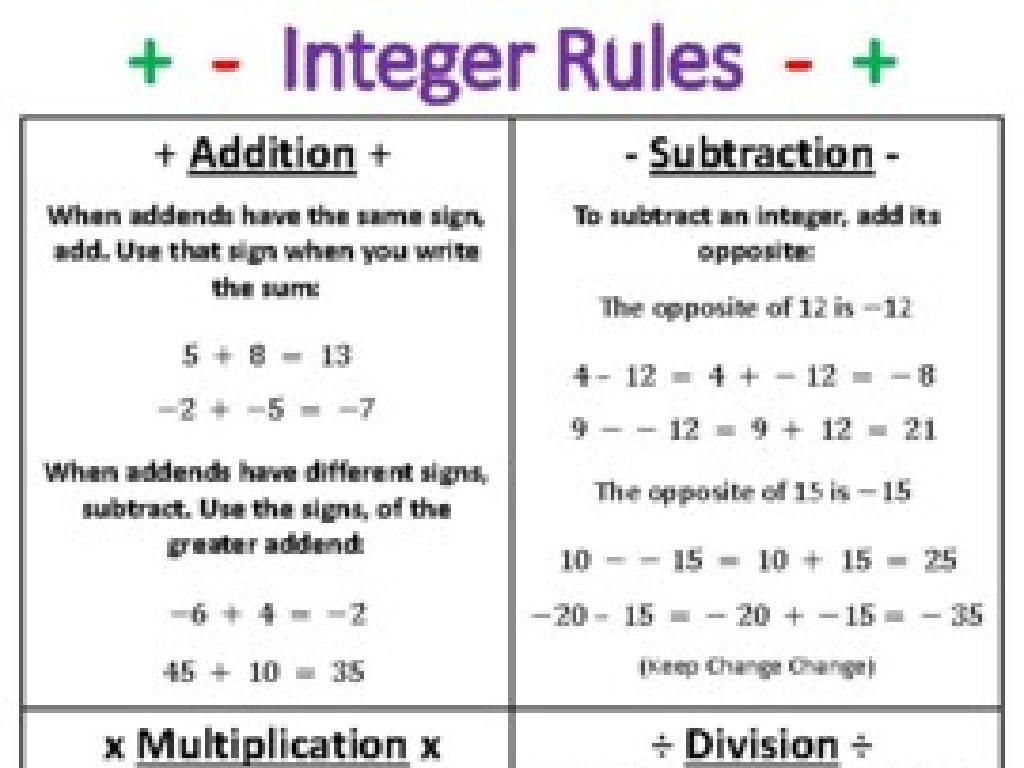Perimeter Of Polygons
Subject: Math
Grade: Fourth grade
Topic: Perimeter
Please LOG IN to download the presentation. Access is available to registered users only.
View More Content
Welcome to Perimeter Exploration!
– Perimeter is a math adventure
– It’s the border length around a shape
– Like a fence around a yard or frame around a picture
– Perimeter has practical uses
– Helps in real life, like buying fencing for a garden
– Let’s find out why it’s important
|
This slide introduces the concept of perimeter to fourth-grade students, aiming to spark their interest by describing it as a mathematical adventure. Begin by explaining that the perimeter is like a path that goes all the way around the outside of a polygon. Use everyday examples, such as the length of a fence needed for a yard or the border of a picture frame, to illustrate the concept. Emphasize the practical applications of understanding perimeter, such as determining the amount of material needed for a project. Encourage students to think of other areas where knowing how to calculate perimeter could be useful. The goal is to create a foundation for understanding and to motivate students to learn how to calculate perimeter themselves.
Understanding Polygons
– Define a polygon
– A shape with straight sides, closed, and no curves
– Examples of polygons
– Triangles, squares, and rectangles
– Non-examples of polygons
– Circles, ovals, and figures with open sides
– Clarify understanding
|
Begin the lesson by defining a polygon as a flat shape with straight sides that are fully connected to make a closed figure. Show students various examples of polygons such as triangles, squares, rectangles, and pentagons. To help solidify their understanding, also show non-examples like circles, ovals, and figures with open sides or curves, explaining why these do not qualify as polygons. Encourage students to ask questions and provide more examples to ensure they can differentiate between polygons and non-polygons. This foundational knowledge will be crucial as they learn to calculate the perimeter of these shapes.
Exploring Perimeter of Polygons
– Perimeter: total distance around
– Think of it as the fence around a yard
– Measuring polygon sides
– Use a ruler to measure each side in inches or centimeters
– Add sides for perimeter
– After measuring, use addition to combine all side lengths
– Practice with different shapes
|
Introduce the concept of perimeter by comparing it to something familiar, like a fence around a yard. This helps students visualize the concept. Demonstrate how to measure the sides of different polygons using a ruler, emphasizing the importance of consistent units (inches or centimeters). Guide students through the process of adding all the side lengths together to find the total perimeter. Include practice examples with various shapes to reinforce the concept. Encourage students to explain their thought process as they measure and calculate, fostering a deeper understanding.
Calculating Perimeter of Polygons
– Perimeter of regular polygons
– Add up the length of all equal sides
– Perimeter of irregular polygons
– Each side may be a different length
– Measure sides with a ruler
– Use a ruler to find the length of each side
– Add all side lengths together
|
This slide introduces students to the concept of perimeter in the context of both regular and irregular polygons. Begin by explaining that the perimeter is the total distance around the edge of a polygon. For regular polygons, where all sides are equal, students can simply multiply the length of one side by the total number of sides. For irregular polygons, they must measure each side individually and then add those lengths together. During the activity, provide rulers and have students practice measuring the sides of various polygons. Encourage them to check their measurements with a partner for accuracy. As an extension, students can draw their own polygons and calculate the perimeter, or find objects in the classroom to measure and calculate the perimeter.
Perimeter of a Rectangle
– Perimeter equals two times sum of length and width
– Example: Rectangle with sides 5 and 3 units
– If length is 5 units and width is 3 units, Perimeter = 2(5+3) = 16 units
– Practice: Calculate a rectangle’s perimeter
– Use the formula with different lengths and widths
|
This slide introduces the concept of finding the perimeter of a rectangle. The formula for calculating the perimeter is given, and students are shown an example with a rectangle of length 5 units and width 3 units. The practice problem encourages students to apply the formula to find the perimeter when given the dimensions of length and width. Teachers should explain that the perimeter is the total distance around the rectangle and ensure students understand how to use the formula by plugging in the given values for length and width. Encourage students to solve the practice problem in class and provide additional examples with varying dimensions to reinforce the concept.
Perimeter of a Square
– Perimeter equals 4 times one side
– Example: Square with 5cm side
– If one side is 5cm, Perimeter = 4 x 5cm = 20cm
– Practice: Calculate a square’s perimeter
– Given one side, use formula to find perimeter
|
The perimeter of a square is calculated by multiplying the length of one of its sides by four, since all sides of a square are equal. Start by explaining the formula for finding the perimeter of a square. Provide a clear example, such as a square with a side length of 5cm, and demonstrate how to apply the formula to calculate the perimeter (4 x 5cm = 20cm). For the practice problem, give students a square with a known side length and ask them to find the perimeter using the formula. This exercise will help reinforce their understanding of the concept and the application of the formula. Encourage students to check their answers with a partner to promote collaboration.
Finding Missing Sides in Polygons
– Learn to find unknown sides
– When one side length is missing, we can use the total perimeter to figure it out.
– Use perimeter to solve for a side
– If a rectangle’s perimeter is 20 and one side is 5, the opposite side is also 5. We use 20 – (5+5) to find the remaining two sides.
– Class activity: Find the missing side
– Work in pairs to solve problems on finding missing sides of various polygons provided in the activity sheet.
|
This slide introduces the concept of finding missing side lengths of polygons by using the given perimeter. Start by explaining that the perimeter is the total distance around the outside of a polygon and that if we know the perimeter and the length of some sides, we can find the unknown sides. Use an example like a rectangle to illustrate this concept. For the class activity, provide students with worksheets that have different polygons with one or more sides missing and the total perimeter given. Have them work in pairs to calculate the missing lengths. This activity will help reinforce their understanding of the relationship between side lengths and perimeter. Offer at least four different polygon shapes for variety and to cater to different learning paces.
Perimeter in Real Life
– Understanding perimeter’s usefulness
– Example: Fencing a yard
– To enclose a space, we measure the yard’s edges to buy the right amount of fence
– Discussing other perimeter uses
– Can we think of places like parks or pools? How about picture frames?
– Encouraging practical thinking
– Think of everyday objects at home or school where perimeter is important
|
This slide aims to show students how the concept of perimeter is applied in everyday life, reinforcing its importance and practicality. Start by explaining that perimeter is the total distance around the edges of a shape. Use the example of fencing a yard to illustrate how knowing the perimeter helps in purchasing the correct amount of fencing material. Encourage students to think of other areas where knowing the perimeter is essential, such as constructing a swimming pool, framing a picture, or even laying out a race track. Ask them to come up with their own examples and discuss as a class. This will help them understand the relevance of what they learn in math class to the real world.
Class Activity: Perimeter Hunt
– Find classroom objects to measure
– Calculate each object’s perimeter
– Use a ruler or tape measure for straight edges
– Record your measurements
– Write down length of all sides, then add them
– Share findings with the class
|
This interactive activity is designed to help students apply their knowledge of perimeter in a fun and engaging way. Provide students with rulers or tape measures and instruct them to find various objects around the classroom, such as books, desks, or windows. They should measure the sides of these objects (if they are polygons) and calculate the total perimeter by adding all the side lengths together. Encourage them to record their measurements and calculations. After the hunt, ask students to present their findings to the class, discussing any challenges they faced and how they overcame them. This will reinforce their understanding of perimeter and allow them to see how it applies to real-world objects. Possible variations of the activity could include measuring items of different shapes, working in pairs, or even creating a small competition to see who can find the object with the largest or smallest perimeter.
Perimeter Review and Pop Quiz
– Recap perimeter concepts
– Perimeter is the total distance around a shape
– Engage in a pop quiz
– Answer questions on perimeter calculation
– Discuss quiz answers
– We’ll review the correct answers together
– Open floor for questions
|
This slide is designed to consolidate the students’ understanding of the concept of perimeter. Begin by reviewing the key points about perimeter, emphasizing that it’s the total distance around the edge of a polygon. Follow with a pop quiz consisting of a few short questions to assess their grasp of the topic. After the quiz, go through the answers as a class to provide immediate feedback. Finally, open the floor for any questions the students might have, ensuring they feel comfortable with the material before moving on. For the quiz, prepare simple questions like calculating the perimeter of a rectangle or square with given dimensions, and encourage students to explain their thought process.
Homework: Practice Perimeter of Polygons
– Practice calculating perimeter
– Complete the worksheet provided
– Worksheet has various polygons to calculate their perimeters
– Note different polygon shapes
– Triangles, rectangles, and more
– Bring questions to next class
|
This homework assignment is designed to reinforce the day’s lesson on calculating the perimeter of various polygons. The worksheet includes a range of shapes to ensure students practice with different types of polygons. Encourage students to remember that the perimeter is the total distance around the edge of a polygon and can be found by adding the lengths of all sides. Remind them to show their work for each problem and to write down any questions they encounter. In the next class, allocate time to address these questions and review the homework to solidify their understanding.






